International Women's Day Edition: Supersisters! Feminism, Counterhistory, and the American Trading Card

In honor of International Women’s Day, this article will introduce readers to the oft-neglected story of Supersisters, a 72-pack trading card series released in 1979 that was created to celebrate 72 trailblazing American women who left an indelible mark on life in the 20th Century.
From its origins in the later decades of the 19th Century up through 1979, collectible trading cards were a popular form of American mass visual culture whose imagery almost exclusively honed in on male subjects. With the perpetual ascent of sporting culture in the 1920s onward, sports-themed cards were churned out in great demand; unsurprisingly, all of these featured male figures and were subsequently catered to a predominantly male audience, despite the contemporaneous existence of women in athletics. The concurrent rise of superhero culture brought another strain of collectible cards that, too, vied for heroicized machismo through fictitious characters like Batman and Superman.

Eventually, a pair of sisters from the quiet suburbs of Upstate New York and Connecticut would conceive a novel take on the collectible trading card and what it could communicate to mass audiences in the age of Second Wave Feminism. In 1978, Lois Rich’s daughter, Melissa, who was an enthusiastic little league baseball player and collector of baseball trading cards, inquired as to why there were no cards dedicated to women, nevermind the fact that she played on an all-boys team. Rich later contacted her sister, Barbara Egerman, to inform her about this issue and the two began to concoct a revolutionary idea. Starting with a grassroots approach, Rich and Egerman surveyed their communities about individuals’ familiarity with notable women. Aside from mentions of a few First Ladies or the cast of Charlie’s Angels, the responses were quite dismal, especially from children.
Nevertheless, the two feminists set to work in conceptualizing an entire trading card series focusing on 20th Century American women who were the firsts in their respective fields and / or contributed to a major historical development. Having been provided a modest grant of $3000 by the New York State Education Department, the soon-to-be Supersisters series had to be limited to only 72 women subjects. Prior to this cut-off point, Rich and Egerman contacted over 500 prospective candidates for consideration and were met with resounding support, from social activist Gloria Steinem (b. 1934) to Olympic swimming champion Wendy Boglioli (b. 1955) (both of whom were incorporated in the series).
Drawing upon the visual formatting of a standard baseball card, Supersisters cards were double-sided, with the front displaying a photograph of its subject framed in a bold red-yellow frame with their name underneath, the Supersisters trademark in the top left corner, and the subject’s corresponding number in the upper right (for horizontally-positioned cards, the trademark is on the bottom left and the person’s name towards the lower right). On the back, a brief heading lists their birth date (a few women opted to not list their age), birthplace, and then-current home / place of work. Below this section, a few short paragraphs go into more detail on the life and significance of the subject followed by an inspirational quote.
The original 72-pack card series spotlighted women in the fields of athletics, education, politics (both Democratic and Republican politicians), journalism, science, arts & entertainment*, religion, social activism, literature, and business. Featured subjects include: Congresswoman Bella Abzug (1920 - 1998), poet Ntozake Shange (1948 - 2018), journalist Jane Pauley (b. 1950), actress Ruby Dee (1922 - 2014), rabbi Sally J. Priesand (b. 1946), race car driver Janet Guthrie (b. 1938), Civil Rights activist Rosa Parks (1913 - 2005), surfer Laura Lee Ching (b. 1950), et al. (*though arts & entertainment is listed here, there were, sadly, no subjects pertaining to the Visual Arts).
Upon completion of the first set, Rich and Egerman intended to distribute their cards on a community-level until a February 5, 1980 New York Times article swept the two in the national spotlight, particularly after photos of the Gloria Steinem card were reproduced. And from that point, Supersisters enjoyed a meteoric rise in popularity to which over ten thousand sets of cards were sold on demand.
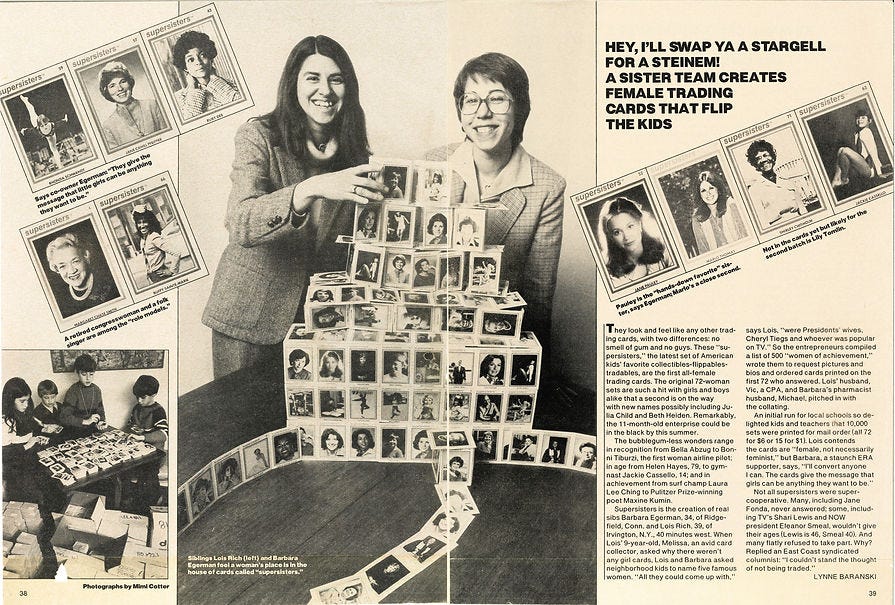
Since education was the ultimate goal behind this series, many of the Supersisters sets were sent to classrooms with the following instructions on how they are meant to function for both female and male students:
Supersisters cards can be used to:
1. Increase awareness of the contributions of women to society
2. Counteract sex-role stereotyping
3. Introduce a wide variety of career possibilities
4. Add to knowledge of current events and issues
5. Provide peer-approved reading and language skills material
However, Supersisters had its share of opposition. During the late-1970s & early-1980s, there was a forceful resistance to Feminism and the proposed Equal Rights Amendment by both conservative men and women, particularly the highly polarizing Republican anti-feminist Phyllis Schlafly (1924 - 2016; Rich and Egerman deliberately avoided any consideration for her inclusion in the series along with anti-LGBT activist Anita Bryant). As such, many criticized the series for its close associations with the feminist movement. There was also another form of opposition that took issue with the manner in which the cards were designed. Since the aesthetics of the Supersisters cards were inspired by both sports and superhero trading cards, DC Comics sent a cease-and-desist letter that attempted to put a complete stop to the series. Thankfully, a court settlement ruled that the word “Super” could still be used, but without the red-yellow colors because of its visual similarity to that used in the Superman franchise. Even from a retroactive standpoint, some critics have chided that the series was merely a minor fad, as one blogger snarkily wrote in 2005: “It’s sort of hard to imagine kids getting excited about them [Supersisters cards] — ‘Hey, I’ll trade you two Bella Abzugs for a mint Shirley Chisholm!’”

Around 1984, Rich and Egerman planned on launching a second iteration of the Supersisters series, which would have included brand new subjects such as the poet Maya Angelou (1928 - 2014) and children’s author Judy Blume (b. 1938). Unfortunately, this follow-up project did not come to fruition due, in part, to the passage of time and Rich and Egerman returning to their personal and professional lives. Despite this pause in production, one can find a number of articles in which people who grew up during the late-1970s & early-1980s continued to hold on to their cherished Supersisters trading cards and fondly recalled the positive influences its depicted role models exerted on its school-age audiences. Most remarkably, Melissa Rich, the impetus behind this major project, took inspiration from the Margaret Mead card and utilized its inspirational quote for her Dartmouth application essay and later went on to manage an educational resource company in San Francisco.
Along with reams of personal testimonies on the truly extraordinary influence they wielded on a person-to-person level, Supersisters has been deemed an important component of late-20th Century American visual culture worthy of institutional preservation. Physically pristine and complete packs of the Supersisters trading cards are safely housed in museum and library collections, most prominently The Metropolitan Museum of Art’s Jefferson R. Burdick Collection of the Drawings and Prints Department, The University of Iowa Libraries and The Feminist Institute (who not only archived, but also digitized the entire series). Regarding The Met’s acquisition of the cards, this occurred in 1981, which happened to be the year when Congress signed a bill into law designating the recognition of Women’s History Week (the first one being the week of March 7 - 14, 1982).
With even more work that needs to be undertaken in the pursuit of women’s rights in 2025, the figures emblazoned on the surfaces of the monumental Supersisters trading card series are an optimistic reminder that positive, lasting, and impactful change can be achieved. Take it from Supersister #16, the cultural anthropologist Margaret Mead (1901 - 1978), and the quote she contributed for her card that inspired Melissa Rich: “Try to find something that needs to be done that only you can do.”
Bibliography
Baranski, Lynne. “Hey, I’ll Swap Ya a Stargell for a Steinem! A Sister Team Creates Female Trading Cards That Flip the Kids.” People, April 7, 1980. https://web.archive.org/web/20160310042459/http://www.people.com/people/article/0,,20076183,00.html
Collectibles Insurance Services. “The History of Collectible Trading Cards.” Accessed March 6, 2025. https://collectinsure.com/2021/07/09/the-history-of-collectible-trading-cards/
Markusen, Bruce. “Museum’s Shoebox Treasures exhibit features stuff of collector’s dreams.” National Baseball Hall of Fame and Museum. Accessed March 6, 2025. https://baseballhall.org/discover/museums-shoebox-treasures-exhibit-features-stuff-of-collectors-dreams
Supersisters. “Our Origin Story.” Accessed March 5, 2025. https://www.supersisterscards.com/the-story
Tady, Megan. “Celebrate Women’s History Month with supersistersTM, the first trading cards featuring women of achievement.” Berkshires Week, March 18, 2024. https://www.berkshiresweek.com/theb/supersisters-trading-cards-for-womens-history-month/article_86f7ed28-dcc1-11ee-ba83-cfa2b0d2a853.html
The University of Iowa Libraries. “IDL staff pick: Supersisters trading cards, 1979,” April 8, 2008. https://blog.lib.uiowa.edu/studio/2008/04/08/idl-staff-pick-supersisters-trading-cards-1979/
Winfrey, Katiera. “‘Supersisters’ trading cards and history digitized with help from Feminist Institute.” WISH-TV, August 23, 2022. https://www.wishtv.com/news/multicultural-news/supersisters-trading-cards-and-history-digitized-with-help-from-feminist-institute/
Wulf, Steve. “The Incredibly Quirky True Story Of The ‘Supersisters’ Card Set.” ESPN, March 5, 2015. https://www.espn.com/espnw/news-commentary/story/_/id/12426260/the-incredibly-quirky-true-story-supersisters-card-set
Zanis, Liz. “Collecting Inspiration with Supersisters.” The Metropolitan Museum of Art, April 3, 2014. https://www.metmuseum.org/perspectives/supersisters




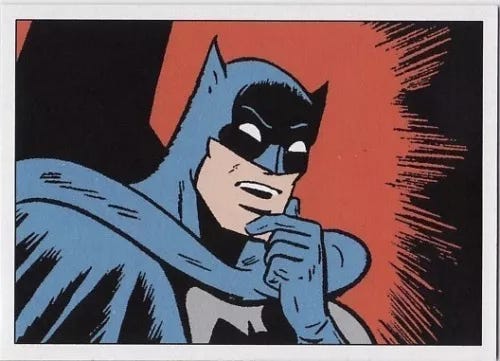

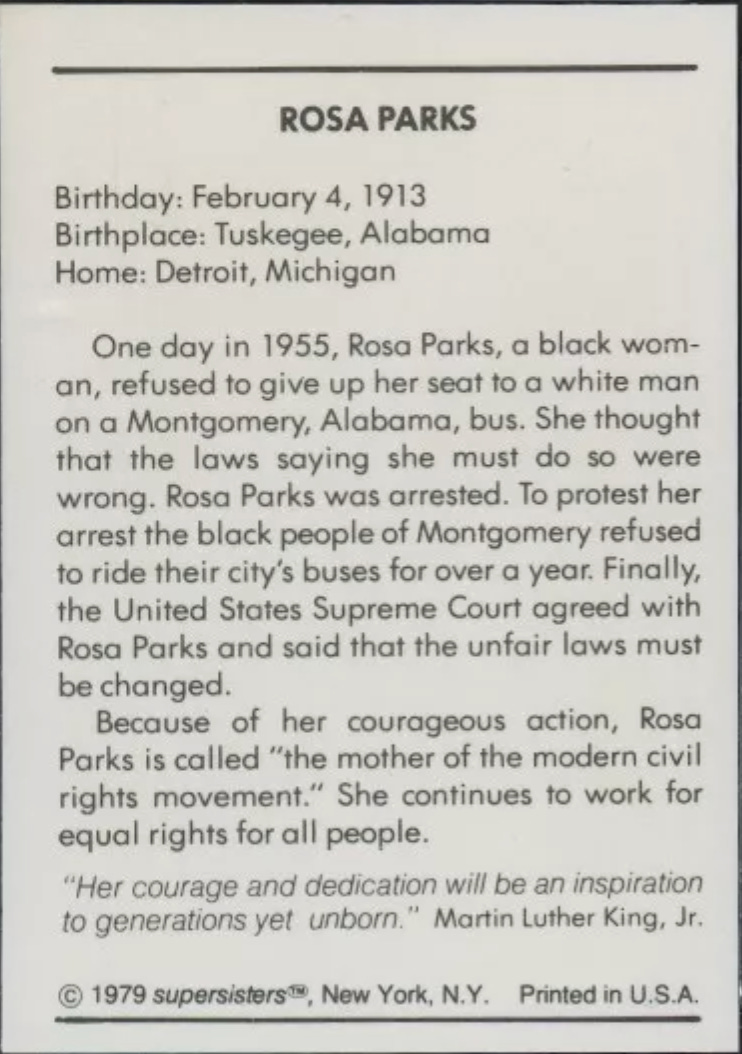
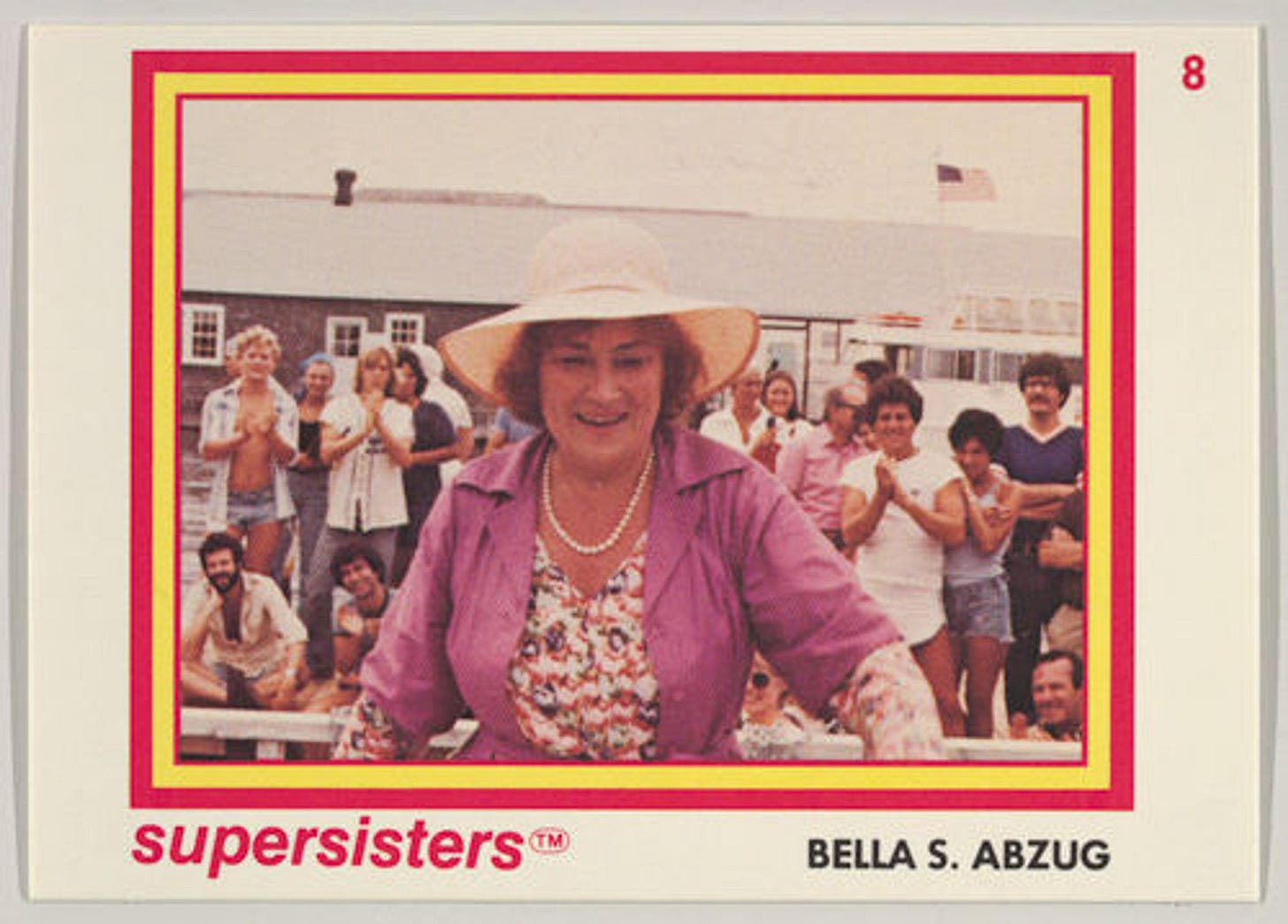
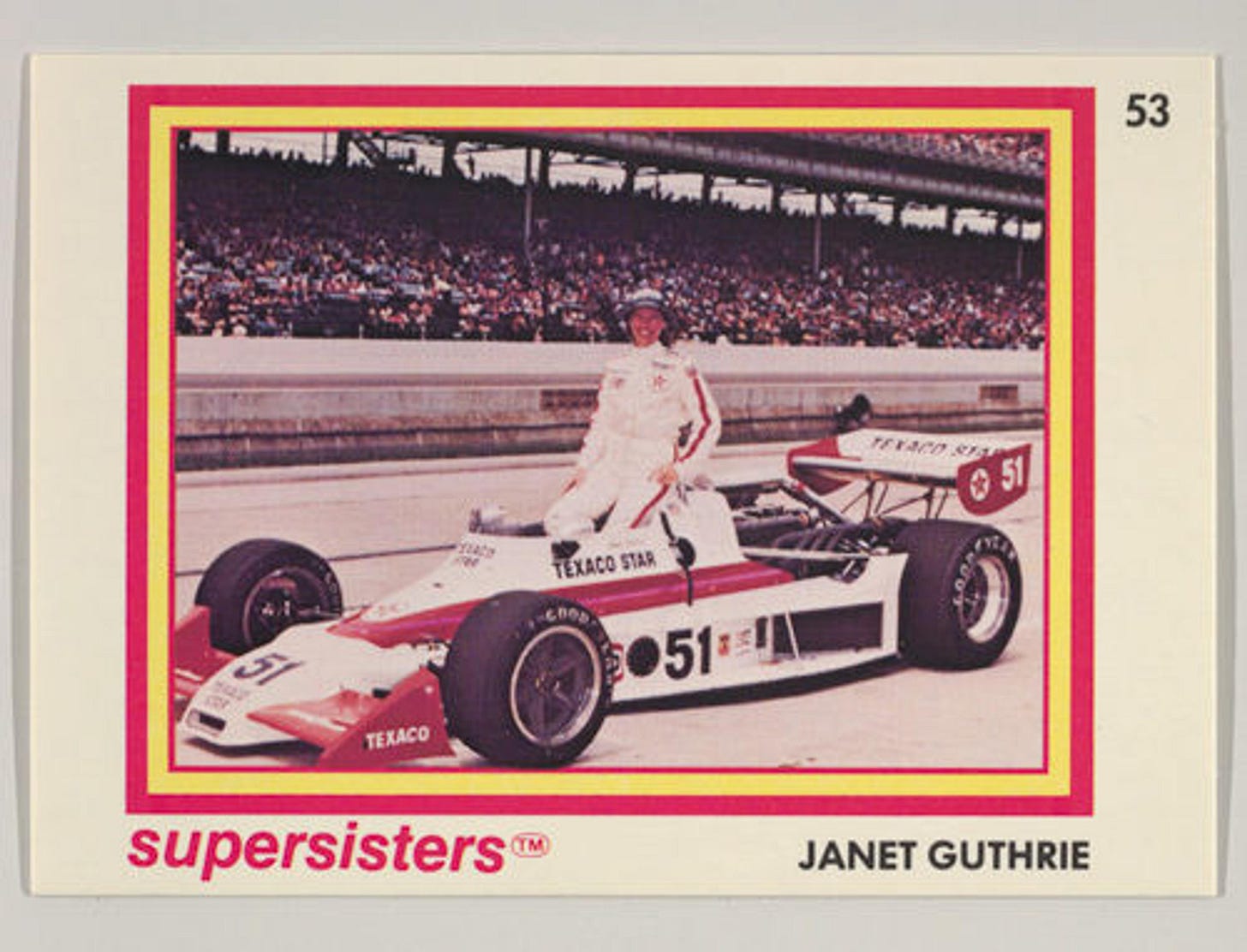
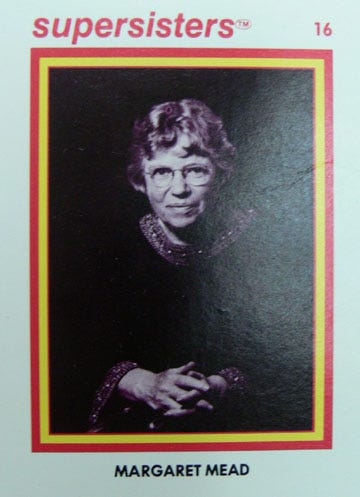
Obsessed...love how often playing cards/trading cards are used as forms of education (and less fun as occasional propaganda) in the US.